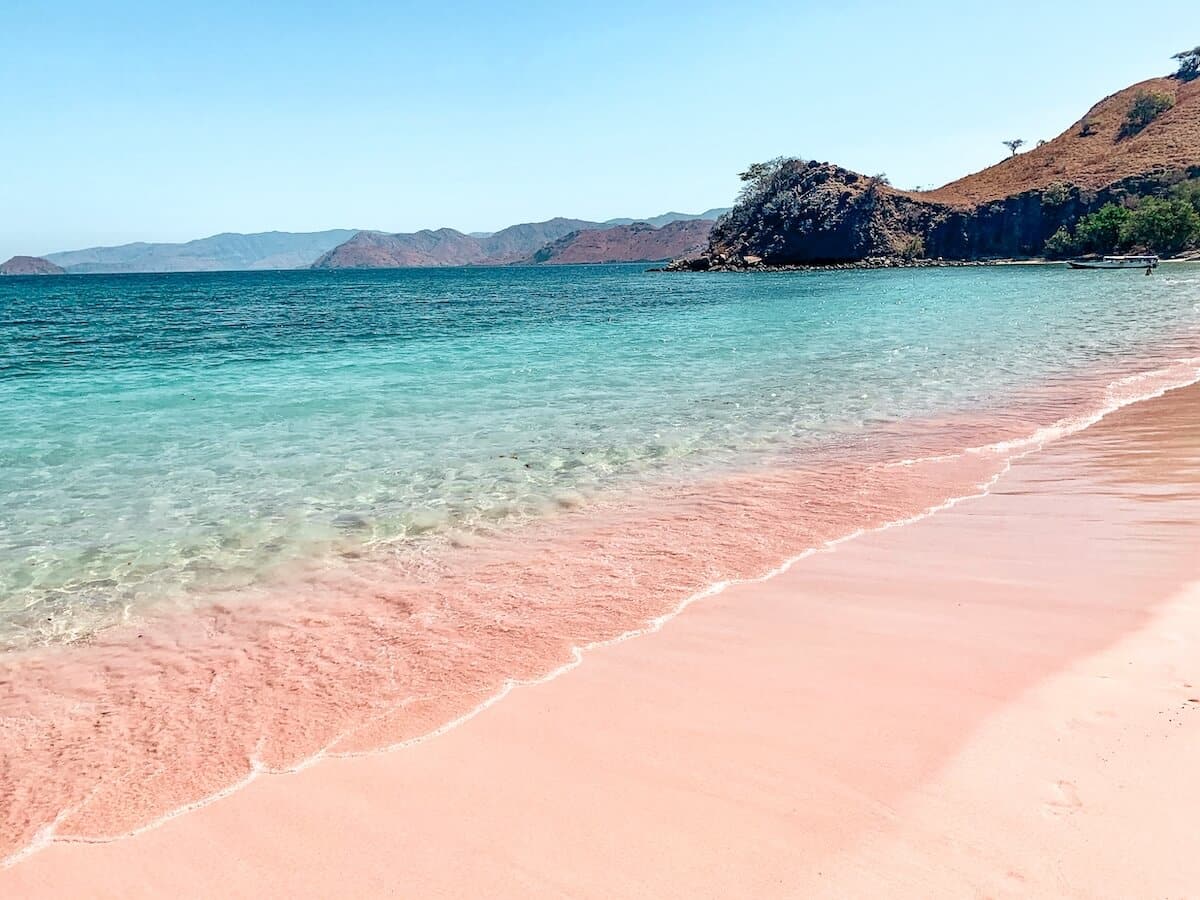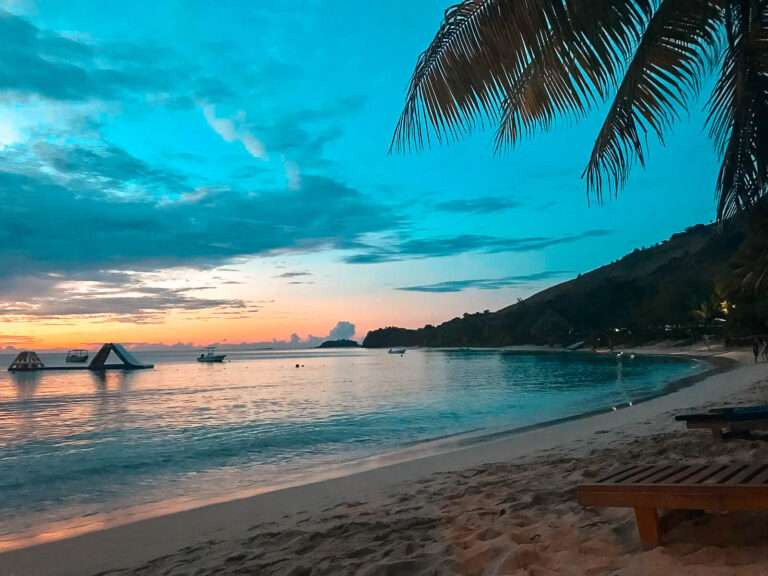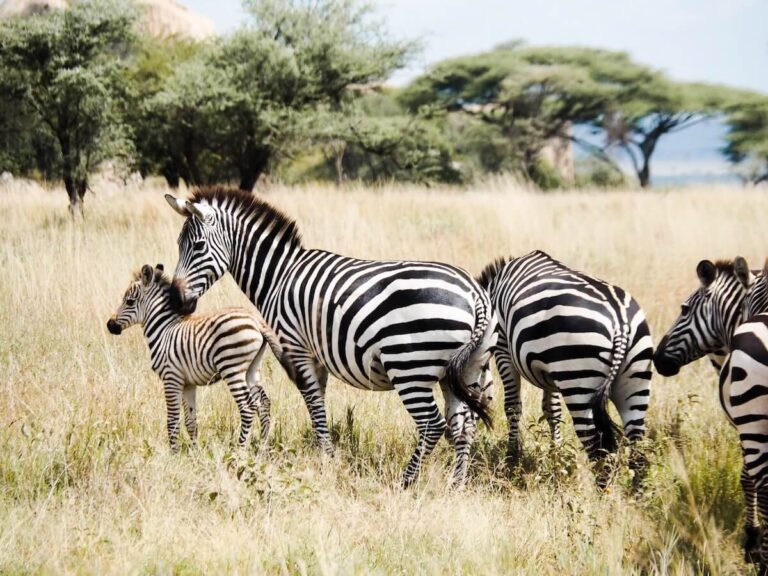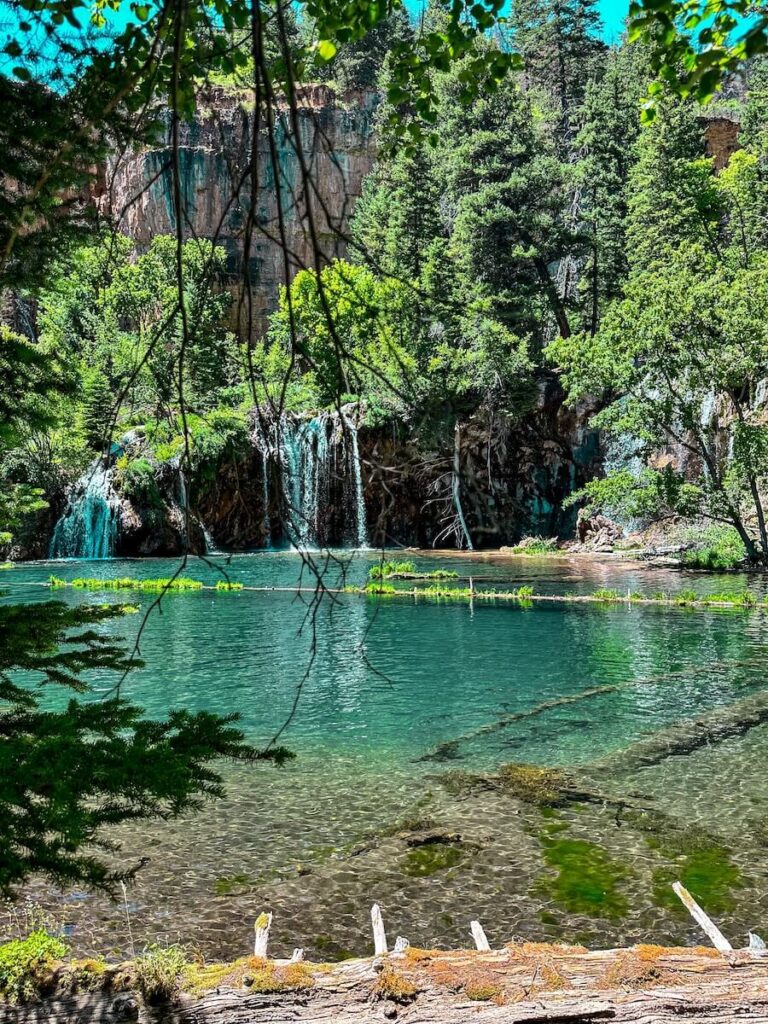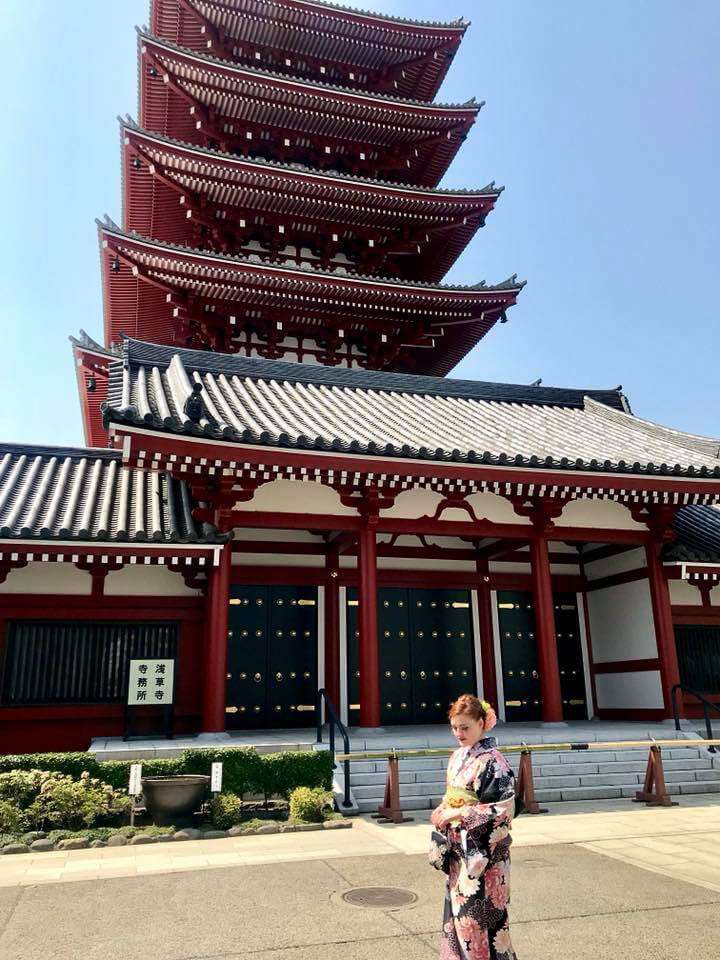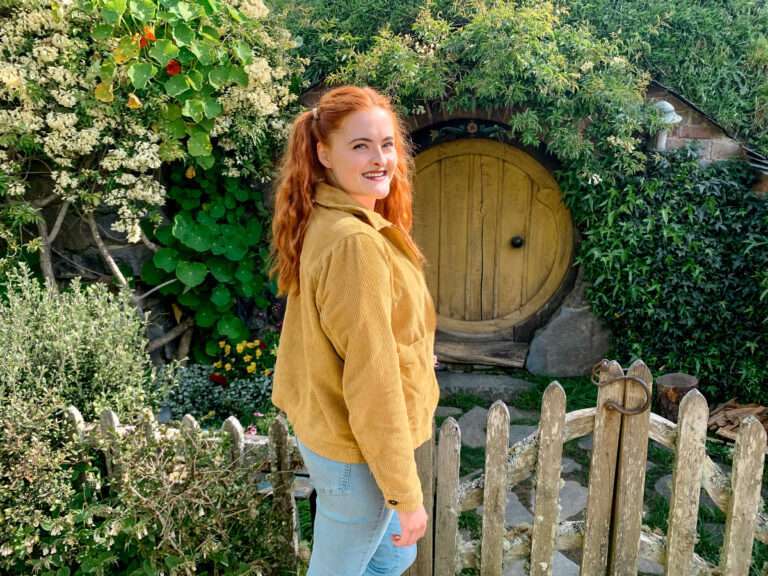The Ultimate Guide to Visiting the Pink Beach in Komodo, Indonesia (+Podcast)
This website contains affiliate links from trusted partners. If you purchase through a link on this site, I may earn a commission at no extra cost to you. As an Amazon Associate, I earn from qualifying purchases. See my Privacy Policy and Disclosure for more information.
Hey adventurers! Welcome back to another episode of Tick It Before You Kick It – the podcast that helps you check off your wildest bucket list experiences.
Today, we’re heading to one of the most jaw-dropping places on Earth—Komodo National Park in Indonesia—to explore something truly magical: pink beaches!
Yep, you heard that right. PINK. SAND. BEACH.
If you’ve ever scrolled through Instagram and stumbled upon a dreamy shoreline with blush-colored sands meeting crystal-clear waters, chances are it was one of Komodo’s famous pink beaches.
But what makes the sand pink? Where are the best spots to see this natural wonder? And what can you do once you’re there? Well, I’ve got you covered!
I am going to say something wild – I’ve been to multiple pink beaches around the world and this beach is hands down the BEST beach I’ve ever been to!
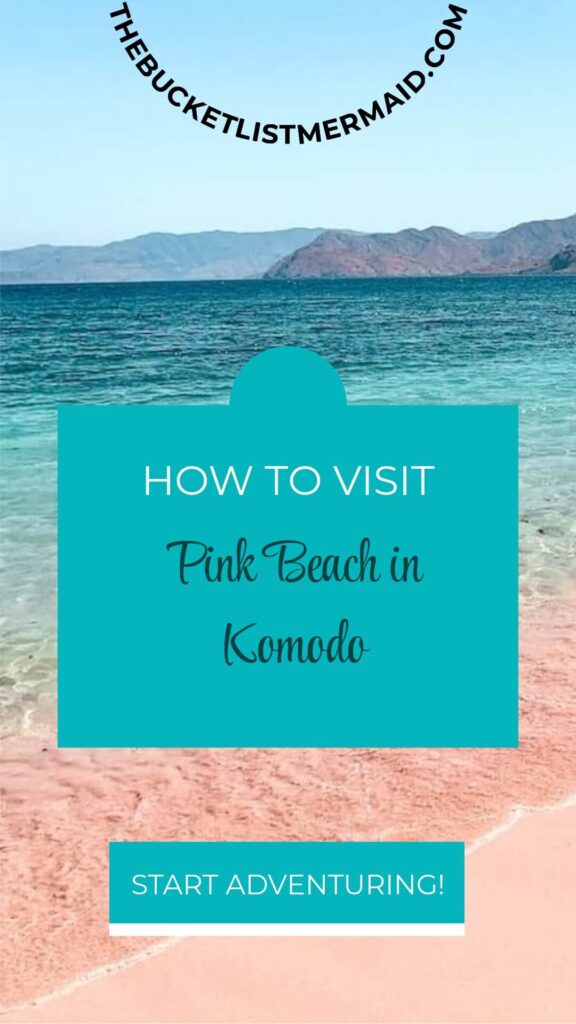
Bucket List Review of the Pink Beach in Komodo
| Category | Beach Remote Relaxation |
| Who Should Add This to Their Bucket List? | Adventurers who want to relax off-the-beaten path |
| Best Time to Go | April to October |
| Traveling Difficulty | Difficult |
| Physical Difficulty | Moderate |
| Popularity Rating | 5/10 |
| Group Tour Required | Yes |
| Budget | $$$ |
| Wheelchair Accessible | Not that I could see… |
| Favorite Place to Stay | Komodo Homestay Near Pink Beach |
| Favorite Tour | Komodo Island Hopper (Get 5% off: ALEXANDRA1GURU) |
| Traveler’s Insurance | Get Quote with VisitorsCoverage |
Listen to My Take on Pink Sand Beaches Komodo
Watch the Video on the Komodo Islands
Why Is the Sand Pink?
Before we dive into the best beaches and things to do, let’s talk about the burning question: Why is the sand pink?
The answer lies in a tiny marine organism called Foraminifera. These microscopic creatures produce a red or pink pigment in their shells, which mixes with the white sand when they die.
Over time, coral fragments, shells, and calcium carbonate from marine life blend together to create that iconic soft pink hue.
The result? A beach that looks straight out of a fairytale!
Pinkness of the sand depends on time of day and the weather.
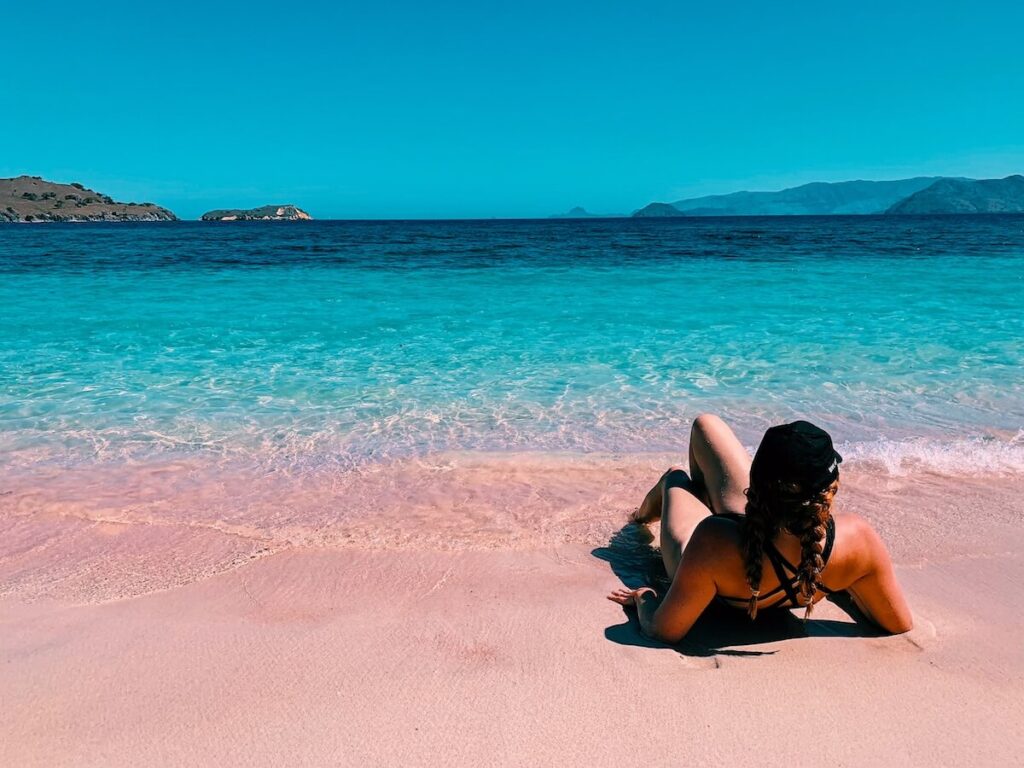
Pink Beaches in Komodo National Park
Let’s get one thing straight – everyone just says “the pink beach” in the Komodo Islands. However, there are actually multiple. Here are the main ones:
1. Pink Beach (Pantai Merah) – The Most Famous One
Located on Komodo Island, this is the most well-known and accessible pink beach.
It’s a must-visit, but because of its popularity, expect to share the beach with other travelers.
2. Long Beach (Padar Island) – The Hidden Gem
Long Beach on Padar Island has a softer pink hue (although this is up to interpretation), thanks to the high concentration of crushed coral.
Plus, it’s a fantastic spot for snorkeling. I’ve also heard this referred to as Namo Beach?
I want to note that there is a lot of conflicting and confusing information. Some say that these are the only two pink beaches, while others claim there is several. Make up your minds!
Odds are if you take a tour, they will naturally just take you to Pentai Merah.
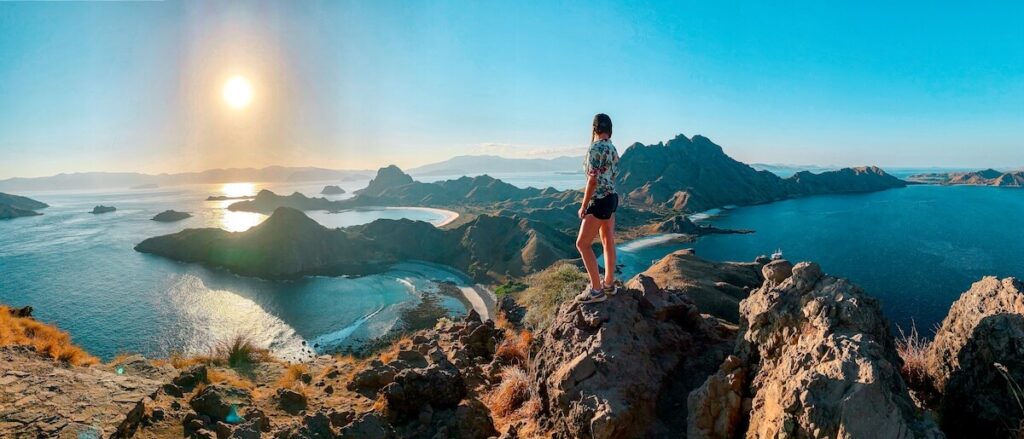
How to Get to The Pink Beach in Komodo
It is worth noting that the pink beaches in Komodo National Park are very remote and hard to get to…but that just makes them even more beautiful!
Because of this, it makes them 100% worth it!
In the map below, you can see both of the notable pink beaches in Komodo across from each other.
- Fly to Labuan Bajo – This small town on Flores Island is the gateway to Komodo National Park. Most trips pick up from Labuan Bajo.
- Hop on a Boat – Take a speedboat or a liveaboard tour to explore the islands.
- Choose Your Adventure – Day trip or multi-day boat tour? Both offer epic experiences!
- Double Check – Make sure that your tour has a stop to at least one pink beach in Komodo.
Potential Fees
When picking a tour, check what costs are covered. Visiting the pink beaches means entering Komodo National Park, which requires a national park permit.
Fees vary, and additional costs may apply for activities like snorkeling or diving. It’s best to check in advance and bring enough cash, as some fees are paid on-site.
When I booked my tour, all fees were covered and paid for.
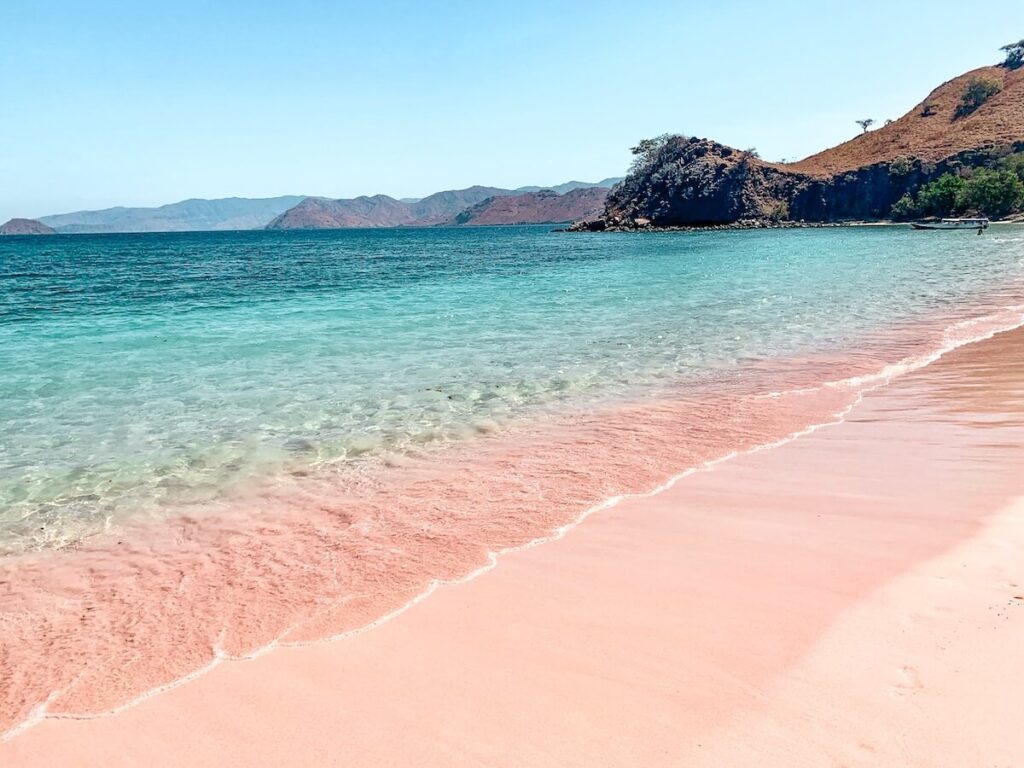
Things to Do at A Pink Beach in Komodo
Snorkeling & Diving
Swim with manta rays, turtles, and vibrant coral reefs.
The best diving is during the dry season.
Some claim that April is the best time because it’s right at the start of the dry season but there is still a chance to see some manta rays.
Bring your own snorkel gear if your tour doesn’t provide it!
Hiking for the Best Views
Climb Padar Island for a breathtaking view of three different-colored beaches. This is a must-do!
It was one of my favorite hikes in all of Indonesia. You get a view of the entire island! Our guide called it the “fidget spinner” because there is a pink, white, and black sand beach on each side of the island!
Meeting the Komodo Dragons
Always go with a guide; these creatures are fascinating but dangerous.
Kayaking & Paddleboarding
Glide over the turquoise waters for a peaceful adventure.
Sunset Chasing
Komodo’s sunsets are unreal, especially from the beaches or on a boat.
Stargazing
I know this is at night but I have to mention it! Some of the best starts I’ve EVER seen where in the Komodo Islands.
I also got very lucky and saw some bioluminescent activity.
This became a joke that I saw “stars above and below in Komodo”.
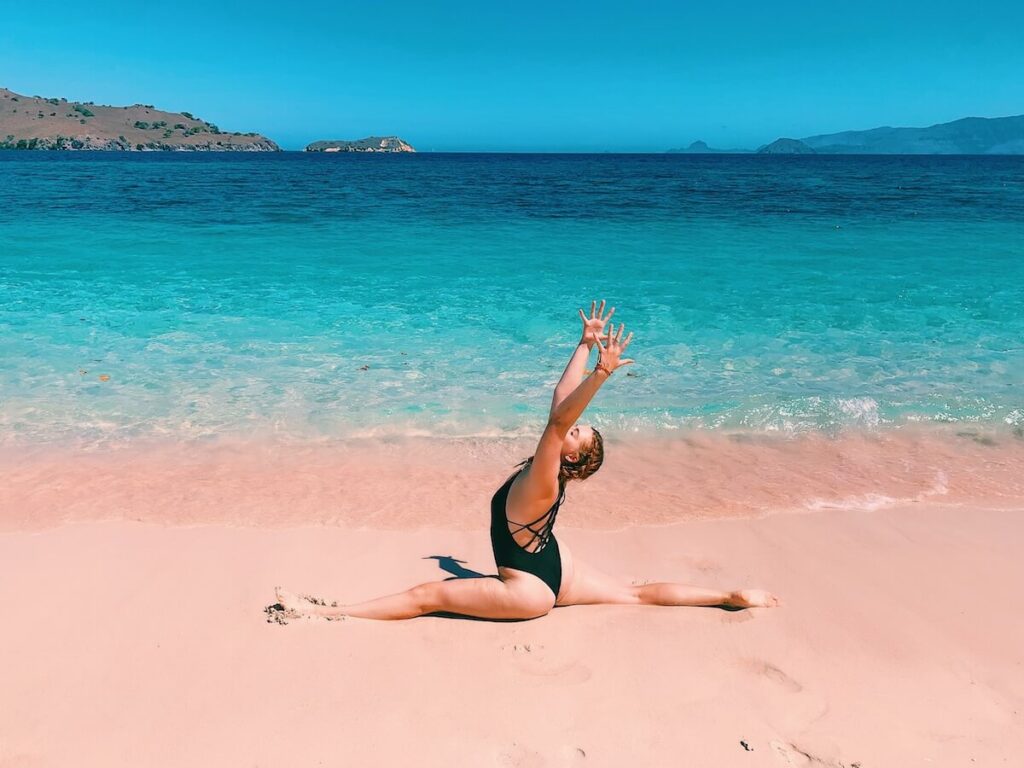
Read More – Full Indonesia Bucket List
Best Tours for Pink Sand Beach in Komodo
There are a wide variety of tours – ranging from one day to multi-day.
Below is the exact tour that I took👇
Or, you can find another one that suites your needs👇
Find More Komodo Island Tours
Best Time to Visit the Pink Beach
- April to October – Dry season, great visibility for diving/snorkeling, but more tourists.
- November to March – Rainy season, fewer crowds, and an intense pink hue, but occasional storms.
Dry Season
The best time to see a pink beach in Indonesia, particularly in Komodo National Park, is during the dry season from April to October.
During this time, the skies are clear, the waters are calm, and the sunlight enhances the pink hues of the sand, making them appear more vibrant.
Midday offers the best visibility when the sun is high, illuminating the coral fragments that give the sand its signature blush color.
However, if you’re after that perfect golden-hour glow for photography, sunrise and sunset create a softer, more ethereal pink tone.
Wet Season
While the rainy season (November to March) sees fewer tourists and a more intense pink color due to moisture-rich sand, unpredictable storms and rougher waters can make access trickier.
For the ultimate experience, plan your visit between May and September when the weather is ideal, and marine life is at its peak for snorkeling and diving.
Read More – Summer Bucket List | Winter Bucket List | Autumn Bucket List (all with free printables!
Komodo Pink Beach Packing List
- Sun protection – hat, sunglasses, reef-safe sunscreen
- Snorkeling gear – if not provided by your tour
- Waterproof camera or phone case – for those epic beach shots
- Cash – for park fees and tips (ATMs are scarce)
- Light clothing and a swimsuit – it gets hot!
For more adventure gear, check out my gear guides or my Amazon Storefront.
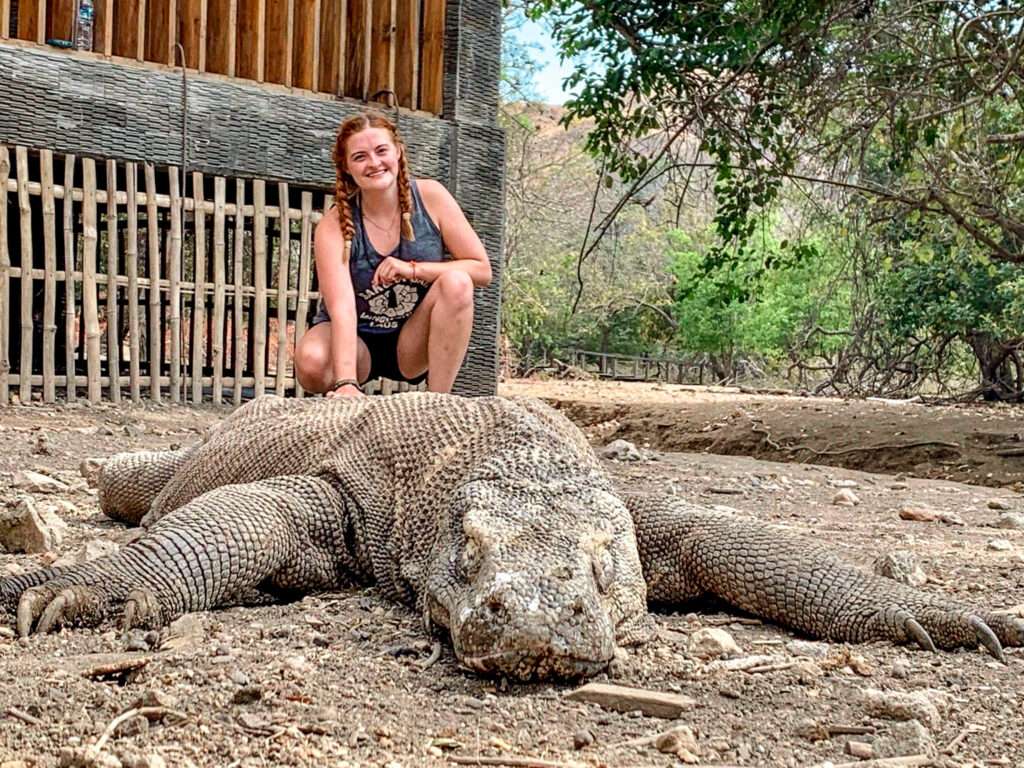
Being Realistic: What You Need to Know
Alright, let’s talk about expectations versus reality. We’ve all seen those jaw-dropping Instagram shots, but here’s what you should really know before you go.
The Pink Hue Varies
The sand isn’t hot pink like a neon flamingo. It’s a soft pink hue, and it changes based on lighting, tides, and the amount of coral in the sand. Midday usually offers the best visibility.
Tourists Are a Thing
If you’re visiting Pantai Merah, expect other travelers. For a more private experience, head to Long Beach.
Although when I went, it was nowhere near the crowds of a common beach.
Getting There Takes Effort
There are no roads leading straight to the pink beaches. You’ll need to fly to Labuan Bajo and take a boat tour.
Komodo Dragons Can Roam Around
This is called “Komodo National Park” for a reason. Any guesses?
That’s right! There are Komodo Dragons here!
Yes, even on the beaches! Always be aware of your surroundings, and listen to your guide.
Personally, I didn’t see any on either pink beach, but it is always worth it to be safe.
The Sand Isn’t Always Instagram-Perfect
Some parts have more white sand mixed in, so the pinkness isn’t always as intense as it looks online.
You will most likely need to edit your photos at least a little bit in order to distinguish it from a normal white sand beach. You do you!
👉Check out a video of the pink sand with ZERO filter up close👈
I more say this because if I see one more over-edited shot of this beach on social media trying to sell it to travelers, I’m going to loose my mind.
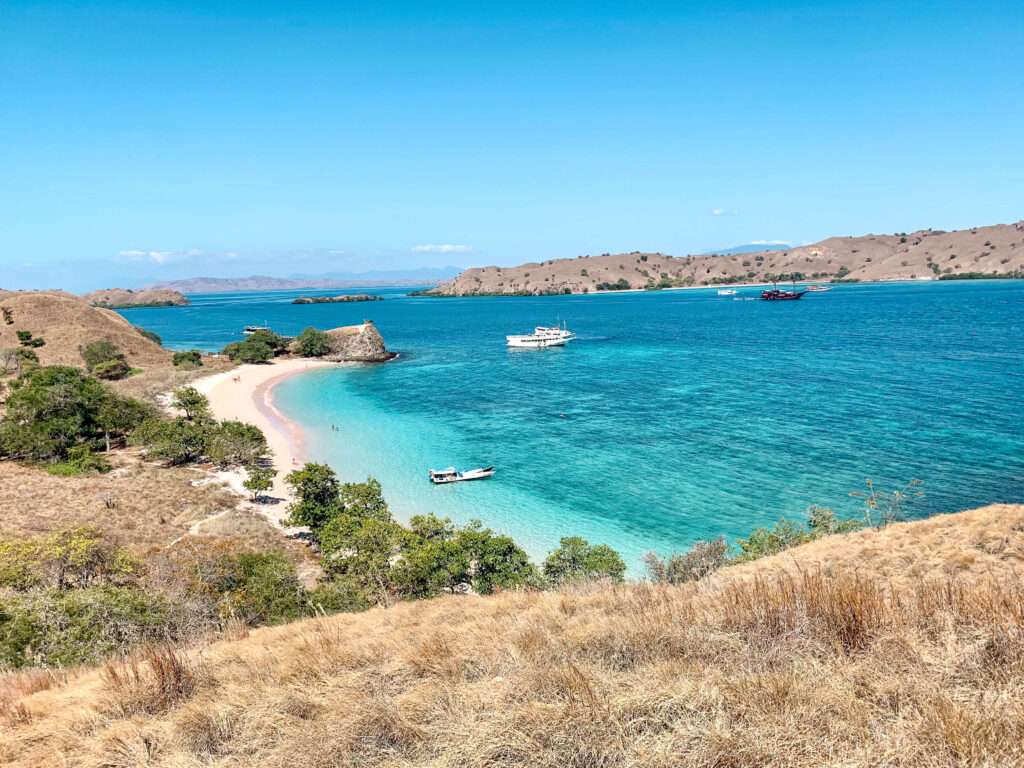
How to Get That Perfect Photo & Editing Tips
How to Photograph Pink Beaches
Below are some simple tips for photographing pink beaches, I wrote an entire guide if you want to go even deeper!
Best Photography Techniques
- Shoot in the Right Light – The pink hue shows best in soft natural light. Aim for midday or golden hour for the most vibrant colors.
- Use a Polarizing Filter – This reduces glare on the water and enhances color contrast.
- Play with Angles – Shoot from a low angle to make the pink sand pop against the turquoise sea.
- Drone Shots are GOLD – If you have a drone, use it! Aerial shots showcase the gradient between the sand and water beautifully. You need a permit for this, have to pay a fee, and there are some “no-fly” zones.
Editing Techniques for That Insta-Worthy Look
- Boost the Reds & Pinks – In Lightroom or Snapseed, increase the red and magenta tones slightly to bring out the pink sand.
- Adjust the Temperature – A slightly warmer tone enhances the beach’s natural colors.
- Increase Contrast & Clarity – This helps define the texture of the sand and the ocean waves.
- Don’t Overdo It – You want the beach to look natural, not like a Barbie dreamland. A slight enhancement is fine, but avoid cranking up the saturation too much.
Final Tips for Visiting the Pink Beach in Komodo
- Leave No Trace – Pack out all trash and avoid stepping on coral.
- Respect the Wildlife – Komodo dragons may look slow, but they’re not! Always go with a ranger.
- Bring Reef-Safe Sunscreen – Protect your skin and the ocean.
- Wear Water Shoes – Coral fragments can be sharp in some areas.
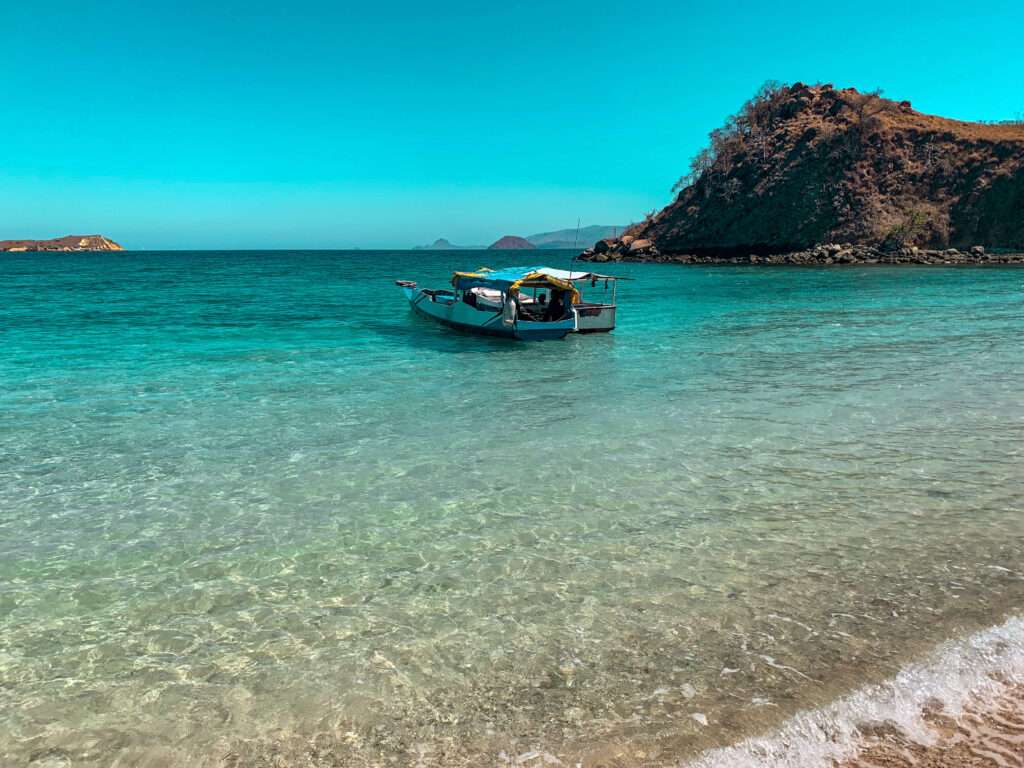
Wrapping Up Your Visit to the Pink Beach in Komodo
Komodo’s pink beaches are truly one of the most magical places on Earth, and I hope this guide has you dreaming of your next bucket list adventure.
Whether you’re lounging on the shore, snorkeling with manta rays, or hiking for epic views, this is a destination that will leave you speechless.
If you enjoyed this episode, be sure to subscribe to the podcast, leave a review, and follow me on social media for more adventure inspiration.
Until next time, keep exploring, keep ticking off that bucket list, and as always—adventure on!
More Travel Resources
Adventure Bucket List Resources
I am here to help your travel adventures go as smoothly as possible! That way you can check off that bucket list with minimal complications and spending!
SHOP – Shop the best adventure gear and essentials on my Amazon Storefront – handpicked by a full-time adventuring mermaid!
AIRFARE – There are a few I use, but Aviasales is normally my go-to for flights without any extra fees or markups.
ACCOMMODATION – My two favorites are Booking.Com for hotels and VRBO for rentals.
GUIDED TOURS – If you are looking for quick and easy tours, check out GetYourGuide and Viator.
MULTI-DAY TOURS – For more in-depth tours that span several days, TourHub has many great options with reputable travel companies. Use my code (ALEXANDRA1GURU) for up to 5% off your next bucket list adventure.
TRANSPORTATION – You can either rent a car yourself with Discover Cars or do a guided bus tours like Big Bus Tours.
SIM CARDS – Avoid expensive roaming charges with an eSim card with Airalo. Personally, I prefer wifi boxes, and recommend WiFi Candy (get 10% of with the code THEBUCKETLISTMERMAID).
TRAVELER’S INSURANCE – Check out VisitorsCoverage for affordable insurance plans. If you are a nomad or remote worker, I would check out SafetyWing.
SEE MORE – Adventure Resources | Photography Resources
See Some Photos You Like?
Check out my full photography page for a full gallery and prices.

